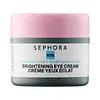What's inside
What's inside
 Key Ingredients
Key Ingredients

 Benefits
Benefits

 Concerns
Concerns

 Ingredients Side-by-side
Ingredients Side-by-side

Water
Skin ConditioningCetyl Alcohol
EmollientCetearyl Alcohol
EmollientGlycerin
HumectantOlea Europaea Fruit Oil
MaskingHelianthus Annuus Seed Oil
EmollientCocos Nucifera Oil
MaskingCI 77947
Alcohol Denat.
AntimicrobialKaolin
AbrasiveCoco-Glucoside
CleansingGossypium Herbaceum Flower Extract
HumectantOryza Sativa Extract
AbsorbentBeta Vulgaris Root Extract
Skin ConditioningArtemisia Umbelliformis Extract
Skin ConditioningEuphrasia Officinalis Extract
AntimicrobialButyrospermum Parkii Butter
Skin ConditioningSaccharum Officinarum Extract
MoisturisingAloe Barbadensis Leaf Juice
Skin ConditioningCarrageenan
Ricinus Communis Seed Oil
MaskingSucrose
HumectantFructose
HumectantGlucose
HumectantInositol
HumectantCitric Acid
BufferingBenzoic Acid
MaskingLactic Acid
BufferingTrehalose
HumectantXanthan Gum
EmulsifyingPotassium Sorbate
PreservativeSodium Benzoate
MaskingSodium PCA
HumectantPhenoxyethanol
PreservativeWater, Cetyl Alcohol, Cetearyl Alcohol, Glycerin, Olea Europaea Fruit Oil, Helianthus Annuus Seed Oil, Cocos Nucifera Oil, CI 77947, Alcohol Denat., Kaolin, Coco-Glucoside, Gossypium Herbaceum Flower Extract, Oryza Sativa Extract, Beta Vulgaris Root Extract, Artemisia Umbelliformis Extract, Euphrasia Officinalis Extract, Butyrospermum Parkii Butter, Saccharum Officinarum Extract, Aloe Barbadensis Leaf Juice, Carrageenan, Ricinus Communis Seed Oil, Sucrose, Fructose, Glucose, Inositol, Citric Acid, Benzoic Acid, Lactic Acid, Trehalose, Xanthan Gum, Potassium Sorbate, Sodium Benzoate, Sodium PCA, Phenoxyethanol
Water
Skin ConditioningCaprylic/Capric Triglyceride
MaskingGlycerin
HumectantGlyceryl Stearate Citrate
EmollientHeptyl Undecylenate
EmollientButylene Glycol
HumectantSilica
AbrasiveJojoba Esters
EmollientC10-18 Triglycerides
EmollientHydroxyethyl Acrylate/Sodium Acryloyldimethyl Taurate Copolymer
Emulsion StabilisingCaffeine
Skin ConditioningSodium Polyacrylate
AbsorbentHydroxyacetophenone
AntioxidantTocopheryl Acetate
AntioxidantCaprylyl Glycol
EmollientSodium Hyaluronate
HumectantPolysorbate 60
EmulsifyingSorbitan Isostearate
EmulsifyingPotassium Cetyl Phosphate
EmulsifyingSodium Benzoate
MaskingChlorella Vulgaris Extract
Skin ConditioningSodium Phytate
Tocopherol
AntioxidantWater, Caprylic/Capric Triglyceride, Glycerin, Glyceryl Stearate Citrate, Heptyl Undecylenate, Butylene Glycol, Silica, Jojoba Esters, C10-18 Triglycerides, Hydroxyethyl Acrylate/Sodium Acryloyldimethyl Taurate Copolymer, Caffeine, Sodium Polyacrylate, Hydroxyacetophenone, Tocopheryl Acetate, Caprylyl Glycol, Sodium Hyaluronate, Polysorbate 60, Sorbitan Isostearate, Potassium Cetyl Phosphate, Sodium Benzoate, Chlorella Vulgaris Extract, Sodium Phytate, Tocopherol
 Reviews
Reviews

Ingredients Explained
These ingredients are found in both products.
Ingredients higher up in an ingredient list are typically present in a larger amount.
Glycerin is already naturally found in your skin. It helps moisturize and protect your skin.
A study from 2016 found glycerin to be more effective as a humectant than AHAs and hyaluronic acid.
As a humectant, it helps the skin stay hydrated by pulling moisture to your skin. The low molecular weight of glycerin allows it to pull moisture into the deeper layers of your skin.
Hydrated skin improves your skin barrier; Your skin barrier helps protect against irritants and bacteria.
Glycerin has also been found to have antimicrobial and antiviral properties. Due to these properties, glycerin is often used in wound and burn treatments.
In cosmetics, glycerin is usually derived from plants such as soybean or palm. However, it can also be sourced from animals, such as tallow or animal fat.
This ingredient is organic, colorless, odorless, and non-toxic.
Glycerin is the name for this ingredient in American English. British English uses Glycerol/Glycerine.
Learn more about GlycerinSodium Benzoate is a preservative. It's used in both cosmetic and food products to inhibit the growth of mold and bacteria. It is typically produced synthetically.
Both the US FDA and EU Health Committee have approved the use of sodium benzoate. In the US, levels of 0.1% (of the total product) are allowed.
Sodium benzoate works as a preservative by inhibiting the growth of bacteria inside of cells. It prevents the cell from fermenting a type of sugar using an enzyme called phosphofructokinase.
It is the salt of benzoic acid. Foods containing sodium benzoate include soda, salad dressings, condiments, fruit juices, wines, and snack foods.
Studies for using ascorbic acid and sodium benzoate in cosmetics are lacking, especially in skincare routines with multiple steps.
We always recommend speaking with a professional, such as a dermatologist, if you have any concerns.
Learn more about Sodium BenzoateWater. It's the most common cosmetic ingredient of all. You'll usually see it at the top of ingredient lists, meaning that it makes up the largest part of the product.
So why is it so popular? Water most often acts as a solvent - this means that it helps dissolve other ingredients into the formulation.
You'll also recognize water as that liquid we all need to stay alive. If you see this, drink a glass of water. Stay hydrated!
Learn more about Water